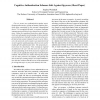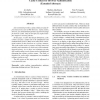SP
2006
IEEE
14 years 1 months ago
2006
IEEE
Can we secure user authentication against eavesdropping adversaries, relying on human cognitive functions alone, unassisted by any external computational device? To accomplish thi...
SP
2006
IEEE
14 years 1 months ago
2006
IEEE
Recently several researchers and practitioners have begun to address the problem of how to set up secure communication between two devices without the assistance of a trusted thir...
SP
2006
IEEE
14 years 1 months ago
2006
IEEE
Timing-based active watermarking schemes are developed to trace back attackers through stepping stone connections or anonymizing networks. By slightly changing packet timing, thes...
SP
2006
IEEE
14 years 1 months ago
2006
IEEE
Hidden services were deployed on the Tor anonymous communication network in 2004. Announced properties include server resistance to distributed DoS. Both the EFF and Reporters Wit...
SP
2006
IEEE
14 years 1 months ago
2006
IEEE
SP
2006
IEEE
14 years 1 months ago
2006
IEEE
Attackers and defenders of computer systems both strive to gain complete control over the system. To maximize their control, both attackers and defenders have migrated to low-leve...
SP
2006
IEEE
14 years 1 months ago
2006
IEEE
The MIX technique forms the basis of many popular services that offer anonymity of communication in open and shared networks such as the Internet. In this paper, fundamental limit...
SP
2006
IEEE
14 years 1 months ago
2006
IEEE
SP
2006
IEEE
14 years 1 months ago
2006
IEEE
The number and the importance of Web applications have increased rapidly over the last years. At the same time, the quantity and impact of security vulnerabilities in such applica...
SP
2006
IEEE
14 years 1 months ago
2006
IEEE
Simulatable security is a security notion for multi-party protocols that implies strong composability features. The main definitional flavours of simulatable security are standa...


